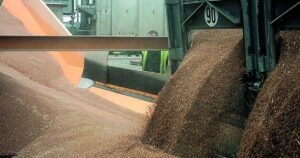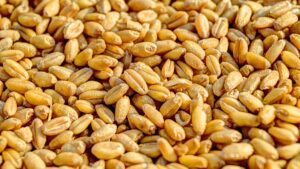
The European Bank for Reconstruction and Development (EBRD) has amended the agreement on the ongoing Dolinskaya – Nikolaev – Kolosovka Railway Electrification Project, which will allow additional use of part of the EBRD loan in the amount of EUR98.5 million to provide liquidity to finance critical needs of JSC “Ukrzaliznytsya” (UZ).
Finance Minister Serhiy Marchenko, EBRD Director for Eastern Europe and the Caucasus Matteo Patrone, and Ukrzaliznytsia Board Chairman Oleksandr Kamyshin signed the corresponding documents on Thursday, the Finance Ministry reported.
The repurposed portion of the EBRD loan will be secured by a guarantee from the French government or another G7 country.
“Damage and destruction of the railway infrastructure, loss of Ukrzaliznytsia’s rolling stock have a negative impact on ensuring the smooth operation of the society. Therefore, an increase in the EBRD loan to support the liquidity of Ukrzaliznytsia will help maintain the stability of its work in war conditions,” Marchenko commented on the agreement.
As reported, earlier this year, on June 10, similar amendments to the agreement were already signed, according to which EUR50 million was directed to support the liquidity of Ukrzaliznytsia. Thus, the total volume of the EBRD loan for the liquidity of UZ reached EUR 148.5 million.

JSC “Ukrzaliznytsia” (UZ) in August 2022 exported a record 1.6 million tons of grain cargo since the beginning of Russian aggression, which is 1.74 times higher than in July (917 thousand tons), this growth was achieved thanks to the unblocking three Ukrainian seaports within the framework of the Istanbul grain agreements.
At the same time, 805,000 tons of grain were transported through land border crossings on the western border last month (in July – 716,000 tons), and 795,000 tons (190,000 tons) were delivered to ports, such data were announced by the Deputy Director of the Department of Commercial Work UZ Valery Tkachev during an online meeting with industry participants on Thursday.
According to him, in August, Ukrzaliznytsia loaded a total of 1.74 million tons of grain cargo into wagons, which is 18.7% of the total loaded volume of 9.28 million tons, and transported a total of 2.08 million tons of grain.
According to him, in August this year, the average daily loading of UZ wagons amounted to 56,000 tons. In early August, this figure varied between 24-40 thousand tons, but with the start of full-fledged operation of the grain corridor under the Istanbul agreements, loading increased to 50-80 thousand tons / day.
“We even have a record for the average daily loading of grain on August 31 – 91.53 thousand tons. I see that we will soon reach the threshold of an average daily loading of 100 thousand tons / day, and I hope that this will be already in September. In general, I see a very positive trend in the transportation of grain cargo,” the Deputy Director emphasized during the meeting.
In August, Ukrzaliznytsia also exported 107.9 thousand tons of sunflower oil, as well as 148.7 thousand tons of all kinds of meal, through land border crossings and ports.
The Deputy Director clarified that over the specified period, the average daily handling of wagons of all types at border crossings dipped slightly – to 1.848 thousand wagons from 1.86 thousand wagons in early August (by 15 wagons per day), however, the transfer of wagons for grain cargo increased by 18 % (+71 wagon/day) – up to 469 grain wagons per day against 398 units. in July.
The UZ representative clarified that by September 1, the total queue of wagons of all nomenclatures at the border had decreased by 21% (or 6.53 thousand wagons) compared to August 1, to 25.12 thousand units. from 31.5 thousand units. At the same time, by the indicated date, 8.48 thousand wagons with grain were in the queue (-15% or 1.5 thousand wagons by August 1), 433 wagons with vegetable oil (half as much) and 605 wagons with meal of all types (- 24%).
“This result was achieved because Ukrzaliznytsia took measures to improve the planning system. Let me remind you that this is the result of the fact that we began to coordinate loading plans according to the algorithm, guided by the delivery indicators for the previous month and taking into account the presence of queues. We are also working with carriers so that they do not inflate the plan, and we confirm only the volume that they are actually ready to take from them at the junction,” Tkachev summed up.

JSC “Ukrzaliznytsia” (UZ) for the period from August 1 to 23, 2022 exported 1.16 million tons of grain cargo, which is 28% more than in July (917 thousand tons), including through land border crossings 549 thousand tons were transported on the western border (in July – 716 thousand tons), and 467 thousand tons were delivered to the ports (last month – 190 thousand tons).
For 23 days of August, Ukrzaliznytsia loaded 1.16 million tons of grain cargo into wagons, which is 17% of the total loaded volume of 6.9 million tons, such data were announced by Valery Tkachev, Deputy Director of the Department of Commercial Work of UZ, during an online meeting with participants industry on Thursday.
“In March, we had 41.6 thousand tons in export traffic, in July – 917 thousand tons, and for 23 days of August we already have 1.16 million tons. Congratulations to everyone, I already see that we are gradually increasing the volumes transportation, but this is still not enough. Let me remind you that before the war we transported up to 4 million tons in export traffic per month,” Tkachev said during the meeting.
He explained that such an increase in exports to Ukraine was ensured by the Istanbul grain agreements, which unblocked the export of grain cargo from three seaports in the Odessa region in August.
“The share of grain both in terms of loading, and in the delivery of wagons, and in joints is growing. This indicates that farmers quickly adapt to the military situation and begin to load and transport more,” the deputy director commented on the increase in the share of grain cargo to 17% in August from 14% in July.
According to him, for August 1-23, the average daily loading of UZ wagons amounted to 50.2 thousand tons, while earlier this figure was 39-47 thousand tons.
According to Tkachev, since the beginning of August, Ukrzaliznytsia has exported 71,000 tons of sunflower oil, as well as 78,000 tons of cakes and meals of all kinds.
The Deputy Director specified that by August 23, the average daily handling of all types of wagons at border crossings had dipped slightly – to 1.84 thousand wagons from 1.86 thousand wagons in early August, however, the transfer of wagons for grain increased by 12% – to 444 wagons per day against 390 wagons at the beginning of the month.
The UZ representative clarified that the total queue at the crossings as of August 23 amounted to 27.1 thousand cars of all nomenclatures, while at the beginning of the month it was 14% more – 31.5 thousand cars. At the same time, by August 23, there were 8.7 thousand wagons with grain (-12% against the beginning of the month) and 506 wagons with vegetable oil (-41%) in the queue.
“In general, the transfer of wagons at the joints is increasing, the queues with grain are decreasing, while we still have a difficult situation at the Romanian border crossings (Vadul-Siret – Dyakovo), at the Polish border crossing Yagodyn-Dorohusk, where business has actively gone, and the difficult situation remains at Batevo – Epereshke,” Tkachev summed up during the meeting.

Ukrzaliznytsia announced the return to the development of a network of regional express trains in western Ukraine, the launch of the Bukovina Express No. 702 Lviv – Chernivtsi and the resumption of the Carpathian Express No. 807/808 Kolomyia – Lviv.
According to information on the UZ website, tickets for “Bukovina Express” are on sale from August 14, and for “Prikarpatsky Express” – from August 15.
“Bukovina Express” via Khodoriv, Ivano-Frankivsk, Kolomyia and Snyatyn will depart from Lviv daily at 17:25 and arrive in Chernivtsi at 22:17. The train will leave Chernivtsi at 7:30 and arrive in Lviv at 11:54.
“Prikarpatsky Express” with a message via Ivano-Frankivsk, Kalush, Dolyna, Morshyn and Stry will depart from Kolomyia daily at 6:10 and arrive in Lviv at 10:40, and return at 17:20 and arrive in Kolomyia at 21:47 .
In addition, UZ announced plans to launch the Dniester Express in the near future, the first flight of which failed in February this year due to the start of a full-scale military aggression of the Russian Federation.
DPKr diesel trains will be used on all routes.

JSC “Ukrzaliznytsia” transported 10.302 million tons of cargo in July, which is 9.2% more than in June this year.
“Domestic transportation, exports and imports have grown. Only transit has not grown, because it is practically non-existent. The transportation of most of our key cargoes has increased: grain, ore, coal, ferrous metals, diesel, building materials, etc. Vehicle transportation has dipped , coke, scrap metal, salt and oil,” Alexander Kamyshin, head of the railway company, wrote on his Telegram channel on the evening of August 1.
According to the data he provided, in July 2022 UZ transported 542 thousand tons of oil and oil products (an increase of 12.2%), 2.033 million tons of ore raw materials (+3.2%), 1.462 million tons of grain (+7.2% ) and 6.266 million tons of other cargoes (+11.6%).
“Yes, the growth is slow. We are doing everything possible for the constant growth of freight traffic, primarily export cargo. I hope that the unblocking of seaports for grain will help us increase grain exports faster,” Kamyshin said.
In domestic traffic, UZ transported 6.2 million tons in July, which is 10.5% more than in June this year.
3.4 million tons of cargo were transported for export, which is 8.7% more than a month earlier.
UZ also transported 598.8 thousand tons of imported cargo in July, which is 4.5 more than in June 2022.